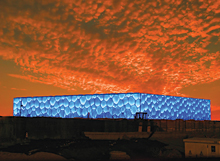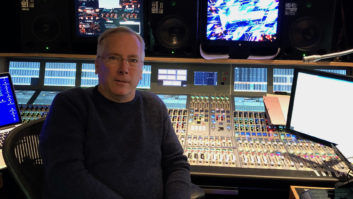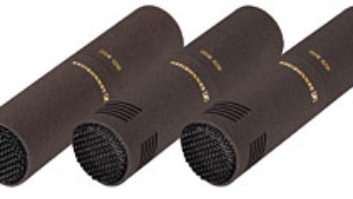
The National Swimming Center
Photo: © Gary718, Shutterstock.com
It goes without saying that televising the Olympics — winter or summer — is a mammoth undertaking, and the complexity of the job has only increased as more and more programming is offered not just on network TV, but also through cable and the Internet, as well as increasingly presented in HD and surround. For this month’s games in Beijing, NBC Universal is promising more than 1,200 hours of coverage across its network and cable stations, plus another 3,500 hours of live streams, rebroadcasts and highlight packages through its www.nbcolympics.com Web hub.
That’s a whole lot of video — and, of course, there has to be audio to go with it. To get an idea of some of the challenges of televising the games from an audio perspective, we contacted two longtime veterans of NBC’s Olympic coverage, both of whom were busy making preparations for the early August launch of the Beijing Games: Jim Starzynski, principal engineer and audio architect of NBC Universal Advanced Engineering in New York (aka, “30 Rock” for its Rockefeller Plaza address), and Bob Dixon, director of sound design and communications for NBC Olympics, who is on the ground in China in charge of coordinating the audio coverage there. Dixon, who’s been designing sound coverage for the Summer Games since 1988 (in Seoul), says it takes up to two years to design the audio end of the Olympics coverage, “and after you get there, you need to go to each site and adjust plans to fit reality. The planning required is huge and filled with detail.”
UPMIX/DOWNMIX
Asked whether anything he learned from working the Athens 2004 (summer) and Turin 2006 (winter) games affected the approach to the Beijing coverage, Dixon replies, “I was not happy with trying to make two channels sound like six. This time, we will be able to transmit six discrete channels from each venue when it’s live and send it directly to our 5.1-equipped home audiences, as long as their local stations are equipped to deal with 5.1; not all are. Now there are times when we have to upmix — for example, if something has been recorded and edited. Our infrastructure still has a lot of hardware that can’t interface with 5.1 so we do a manual downmix to 2-channel at the same time we’re doing our 5.1. We do it manually to tailor and preserve as much as possible the openness of the stereo. The more noncorrelated the 2-mix, the more an upmixer can do with it. This time, we’re trying out the Linear Acoustic UpMax Neo for the upmix and that will happen as the piece gets played out to air.
“I’ve also concluded that microphones need to be delivering noncorrelated signals if you want an upmix to sound alive and spread out,” he continues. “Any matrix upmixing device will deliver identical signals in the left and right channels to the center-channel output. That can very quickly become a pretty big lump of sound.”
Meanwhile, on the New York end, Starzynski adds, “The Beijing games will be the first opportunity that we have to go with discrete audio distribution for the backhaul signal from the International Broadcast Center [IBC] in China to the Broadcast Operations Center [BOC] at 30 Rock in New York City. Our current plan is to use new transport-stream-encoding technology that accepts and encodes an HD-SDI [serial-digital interface] signal with video and data, and up to 12 channels of discrete embedded audio. The integrated receiver/decoder that is receiving the signal at the network in New York City hands off exactly the same HD-SDI signal for integration into plant distribution. This moves us from previous systems that used multiple devices to transport the video, data and multichannel audio, and streamlines what can otherwise be a complicated process.”
GEARING UP ON-SITE
As for the on-site audio production for the multitude of Olympic events, Dixon notes, “We have seven sites with production facilities: athletics [track and field, ceremonies], gymnastics, aquatics [swimming and diving], beach volleyball, boxing, basketball and volleyball. All of these sites have digital audio consoles. Some venues get two when we have someone mixing sound effects and iso record mixes, and the other console does the main show mix. We also have five other locations where the audio mixing is on a much smaller scale. However, a 5.1 mix is available at every venue, so if it’s live, it can go ‘home’ with discrete surround audio.”
In the recent past, the Calrec Q2 has been the top-of-the-line on-site mixing console of choice, but for these games they’ve moved to a more compact Calrec Bluefin Omega because, “We can’t have remote trucks here in China like we would normally,” Dixon explains. “Those trucks have huge, beautiful consoles that let a sound mixer feel anything is possible, but the cost of transportation and paying for them while they’re on the boat made it unfeasible. So we are using fly-packs everywhere. Some are from NEP Visions in England, one is from Bexel in the U.S. and several were designed and built by NBC Olympics. The size and power of a Bluefin Omega is a dream just made for these limitations. Their chief limitations are the number of faders one can have, so for our biggest venues we gave them two each. But the feature set has everything we’re accustomed to having in our biggest remote trucks: having 5.1 inputs on one fader with spill panels to adjust the balance of the stems, and spill panels to enable a simultaneous stereo mixdown. Also, things like 5.1 monitoring with lots of internal and external 5.1 sources. I am very impressed with what Calrec has been able to do in a console of this size.” How many inputs might an event require? “In the past, we had consoles with 128 stereo analog inputs on Calrec Q2 consoles and they were filled, and we even had smaller consoles feeding submixes into them.”
Dixon says that for the smaller-scaled locations, DiGiCo DS-00 desks will suffice: “Our small venues used to be happy with 11 mono inputs and three stereo inputs,” he says, “but HD and surround have exploded the requirements for audio, even if we kept to the same number of elements, which, of course, we haven’t. We’ve added more recording devices and more cameras with stereo microphones on them. But it’s still a smaller event with a smaller budget and smaller amount of space to do it in. Trying to find something in between the Omega and the small digital consoles that aren’t appropriate for television in 5.1 has not been easy, but DiGiCo was very proactive in trying to fill that gap for us. They have a usable number of inputs and outputs, they can monitor internal and external 5.1 signals, they have the build and sound quality, and the price point is very affordable.”
Queried whether the various mixers follow certain approaches to guarantee some sort of sonic consistency to the mixes, Dixon answers, “I have developed guidelines that they must keep in mind as they mix — ambience techniques, keeping things open and separate, not using limiters to do the mix, those kind of issues. But each mixer is quite experienced, and they do live sports for television for a living as freelancers. This is a very professional group experienced in surround coverage.”
Most of the technical setup is being done by people who have worked the Olympics for NBC before — contractors from the U.S., Canada and England mostly — “but we also employ a great deal of local help,” Dixon adds. “We are blessed in Beijing with a lot of local help that’s smart and hard-working.”
MIC ISSUES
Asked about the intricacies of scoping out a given sport site for audio, Dixon says, “It isn’t very different from miking a drum kit, a piano or a stage filled with tap dancers. We have to know each sport intimately — what’s involved and what does that involvement ‘sound like’? Once you can identify the type of sound involved and how that sound is made, you look at where you can get away with putting microphones. Will the International Olympic Committee allow us to put a microphone very close to the source of the sound if we make it invisible to the eye and to feet that might trip over cables? Or will they say we can’t get any closer than 8, 10 or 50 feet?
“For the Winter Games, there are a lot more long-distance sound pickups required,” he continues. “People skiing down a mountain need a lot of microphone operators pointing a lot of shotgun microphones over a very big area. Sounds of the Winter Games have a lot of scraping — edges of skis, edges of ice skate blades, edges of sled runners, curling rocks sliding on the ice. The Summer Games have a lot of footfalls, races, jumps, landings, springs from vaults, diving boards. All these require different techniques. You have to know your microphones: What do they do well? How will they work on capturing this kind of sound from that distance?
“Consider the issue of a 5.1 ambience from an outdoor stadium. The ambience in this case is mostly the sound of the crowd in a very big, open space. We don’t want to mike individuals; we want the sound of a large group. However, we want to preserve the transients of handclaps and have the identifiable sound of a group shouting in unison. We don’t want a bunch of P.A. in this signal either. You have to calculate that you need to have different sounds coming from five different speakers. Using lots of mics is not my favorite thing to do; I think it destroys clarity. But a great directional mic can be suspended with its back to the P.A. speakers and give a nice representation of the sound of a crowd. Do this five times from five different places, and you can get a great foundation for your show mix.
“Sometimes we mike different segments of the audience for their response to a sport happening right in front of them. As examples, athletics, gymnastics and wrestling have several competitions going on at the same time. So we would mike the audience right in that area as a sweetening to the coverage of that competition. We’re using Audio-Technica 4050s at each venue to do this. This gives us the same type of sound from each venue, and I think they are terrific in their openness, clarity, transient response — all the things I want from a high-quality microphone on a job like this.”
DISTRIBUTION — HALFWAY AROUND THE WORLD
Even though 5.1 mixes for all events will be delivered from Beijing, Starzynski assures, “We are also paying close attention to the 2-channel downmixed version of our surround sound audio, as this feeds analog standard-definition stereo viewers, still our largest audience. The network’s standard-definition downmix will be set to Lo-Ro [stereo only] to create the absolute best stereo sound with much attention paid to the return monitoring feed at the main commercial control mixing console in Studio 6A in New York. Mix engineers in China and New York are well aware of the importance of this soundtrack and will be monitoring it most of the time, in addition to frequent checks of the discrete 5.1 for the DTV service and analog and digital air checks of WNBC and WNBC-DT, our station in New York City. We are also paying close attention to maintain a -23dBFS average loudness for the broadcast. Both Beijing and Stateside engineers will make adjustments as needed to create great sound for both SD and HD.” All programming that goes out in stereo only will also have a 5.1 counterpart soundtrack that’s printed on an archival HDCAM-SR videotape should the need arise for surround coverage on that event at some other point. The archiving and repurposing of many feeds to cover promos and feature packages — often involving post sweetening — is handled at 30 Rock.
Starzynski describes the signal chain for a typical event at the Beijing games: “In China, the venue creates audio/video at the event location and sends this via HD-SDI communications hard-line to the IBC. The IBC receives, processes, routes, mixes and ultimately releases this signal via satellite using an MPEG transport stream to NBCU headquarters at 30 Rock. BOC in New York City receives and properly routes the signal to a specific control room assigned to do commercial or release control for that event.
“For commercial control for HD on the DTV network, event and commercial sources are each assigned a separate 5.1 fader on the mix desk and an engineer is responsible for monitoring the signals and timing of the crossfades between sources,” Starzynski continues. “If there’s a concern with the delivered audio, the New York control room contacts the IBC in China asking for a fix to the problem at the point of origin. The output of this room feeds HD distribution and a downmix feeds the Lo-Ro signal to SD distribution.
“BOC then creates multiple time zone feeds on separate distribution channels for HD and SD: The SD signal remains stereo and is distributed digitally to our SD TV stations. Those stations apply processing as necessary to handle dynamics limitations in analog transmission. Each station accomplishes this differently.
“For HD,” Starzynski continues, “the audio signal is demuxed from HD-SDI to AES-3id in BOC for both stereo and 5.1 stations. For 5.1 stations, it’s applied as discrete L/R, C, LFE, Ls, Rs and audio metadata to the satellite encoder. Stereo stations receive a downmix of the 5.1. The DTV stations take the appropriate feed and integrate it in their HD distribution system locally. The audio is ultimately applied to the DTV audio encoder. Surround-capable stations use the network metadata that’s matched properly for loudness and dynamics, and transmit it with the audio to the audience to control home receivers with the network program. Stereo DTV stations send the downmixed network audio to the home, along with metadata chosen and distributed by the station. In the end, the audience receives a high-quality, highly produced 5.1 or stereo digital soundtrack of this world-class event with absolute minimal dynamics processing and consistent loudness.”
Complex stuff, to be sure. So when you hear a 350-pound Bulgarian grunting as he throws the shot put, appreciate not just the effort the athlete has made to hurl that 16-pound metal ball more than 70 feet, but also the precision team of audio pros and high-tech gear required to deliver that grunt to your living room!
Blair Jackson is Mix’s senior editor.







